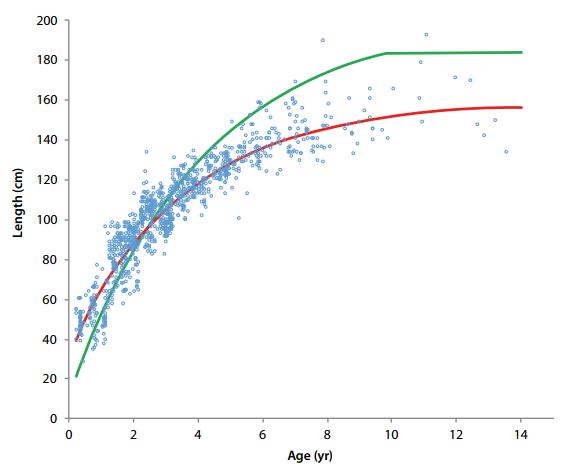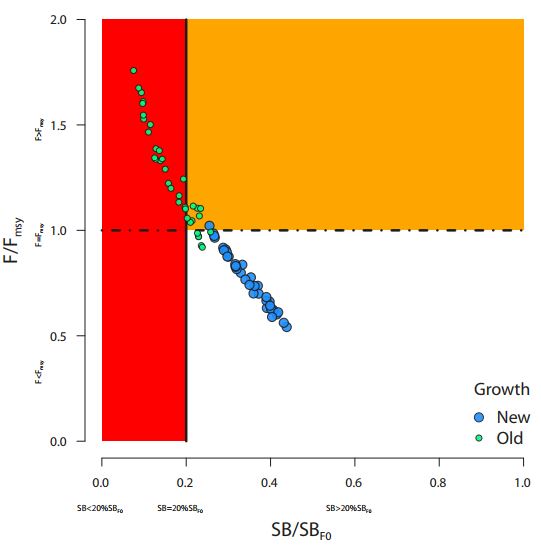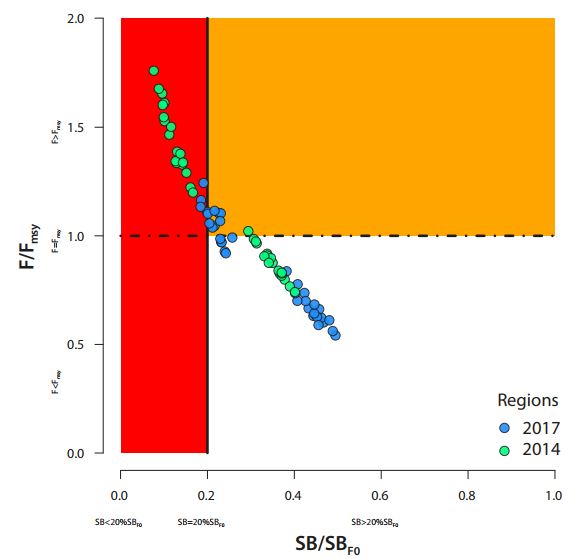The 13th Regular Session of the Scientific Committee (SC13) of the Western and Central Pacific Fisheries Commission (WCPFC)was held in Rarotonga, Cook Islands from 9 to 17 August 2017. A major topic of debate at SC13 was the new bigeye tuna(Thunnus obesus) stock assessment, which was conducted by the Oceanic Fisheries Programme (OFP) of the Pacific Community.
This new assessment indicates that the bigeye tuna stock is in a healthier condition than suggested by previous assessments that werecarried out in 2011 and 2014. In this article, we outline the changes that were made to the 2017 assessment, why they were doneand what they mean for management.
Previous bigeye tuna assessments
To recap, previous assessments of bigeye tuna conductedby the OFP in 2011 and 2014 had relied on size data – i.e.length frequency and weight frequency samples of catches– to provide information on the rate of growth of bigeyetuna. In those assessments, the mean size of the oldest fishin the population (10 years of age and older) was estimatedor assumed to be around 180 cm, which is equivalent to aweight of around 140 kg. This was consistent with availableinformation on growth from the eastern Pacific Ocean,where the Inter-American Tropical Tuna Commission hadconducted detailed studies on the age and growth of bigeyetuna. However, while these large bigeye tuna are fairlycommon in the eastern Pacific, they are relatively rare inthe western and central Pacific Ocean (WCPO, west of150°W). This is shown in Figure 1. For the history of alllongline catches of bigeye tuna in the WCPO, <0.1% of thehistorical catch has been larger than 184 cm or 140 kg, evenin the very early days of the fishery, when the presence oflarger fish would be expected.
 Figure 1. Weight frequency (A) and length frequency (B) distributions of the longline catch of bigeye tuna, 1952–2015, in the westernand central Pacific Ocean. The red vertical lines represent the mean size of the oldest fish in the longline catch assumed for the 2014assessment. The yellow vertical lines represent the mean size of the oldest fish as indicated by the new growth data.
Figure 1. Weight frequency (A) and length frequency (B) distributions of the longline catch of bigeye tuna, 1952–2015, in the westernand central Pacific Ocean. The red vertical lines represent the mean size of the oldest fish in the longline catch assumed for the 2014assessment. The yellow vertical lines represent the mean size of the oldest fish as indicated by the new growth data.
The rarity of large fish in the catch relative to the biologicalassumptions about the mean size of the oldest fish wasattributed to fishery-induced depletion in the stock assessmentmodel. To reconcile the paucity of large bigeye tunain the catch, the model estimated that few survived to 10years of age or more. The model did this by estimating highlevels of fishing mortality, which greatly reduced the numberof bigeye tuna that lived to older ages; thereby, theywere not able to grow to these larger sizes. This implied alarge fishery depletion effect, and gave rise to the estimatefrom the 2014 assessment that the ratio of the spawning(adult) biomass in 2012 (the final year of the 2014 assessmenttime period) to the spawning biomass estimated tooccur in the absence of fishing, was 0.16 – i.e. the modeldetermined that the stock was 84% lower than it wouldhave been if no fishing had occurred. As this was belowthe agreed ‘limit reference point’ of 0.2 times the unfishedspawning biomass, the stock assessment indicated that thestock was in an overfished state.
The 2017 bigeye tuna assessment
The new bigeye tuna assessment presents a considerablymore optimistic outlook for the current status of thestock and the impacts of fishing (Figure 2). The assessmentupdated the data for the past three years and explored a widerange of uncertainty across 72 separate models that madedifferent assumptions about biological characteristics (e.g.whether the new growth information was used, or that usedin the 2014 assessment) and assessment model settings.This exploration of uncertainty was the most comprehensiveof any WCPFC tuna stock assessment to date. SC13weighted some of these models higher than others (more onthis later), and the overall weighted median ratio of recentspawning biomass to the unfished level was 0.32, with 16%of the model runs falling below the limit reference pointof 0.2 times the unfished spawning biomass. The medianratio of recent fishing mortality to the fishing mortalityat maximum sustainable yield (MSY) was 0.78, with 23% of the model runs exceeding the MSY level. For this newassessment, it therefore appears that the stock is not in anoverfished state nor is it experiencing overfishing. SC13noted that while this assessment is more positive than previousassessments, it is recommended that fishing mortalityshould not be increased from the current level.
 Figure 2. Estimates of historical (to the left of the vertical black line) and projected future bigeye tuna spawning biomassdepletion (SB/SBF0) assuming the continuation of recent levels of fishing2.The different shading of the trajectory representsthe uncertainty in the estimates across 72 model runs that were weighted according to SC13 advice. The horizontal redline represents the limit reference point of 20% of the recent unfished spawning biomass. The solid red circle indicates theestimate of spawning biomass depletion in 2012 from the 2014 bigeye tuna assessment.
Figure 2. Estimates of historical (to the left of the vertical black line) and projected future bigeye tuna spawning biomassdepletion (SB/SBF0) assuming the continuation of recent levels of fishing2.The different shading of the trajectory representsthe uncertainty in the estimates across 72 model runs that were weighted according to SC13 advice. The horizontal redline represents the limit reference point of 20% of the recent unfished spawning biomass. The solid red circle indicates theestimate of spawning biomass depletion in 2012 from the 2014 bigeye tuna assessment.
2.SB/SBF0: The ratio of spawning
So what changed in the 2017 assessment?
Four main things changed in the 2017 assessment, and wediscuss each of these in the following section.
Change 1: Inclusion of new growth data
As early as 2008, the WCPFC Scientific Committee (SC)recognised that the absence of scientific data on age-at-lengthrepresented a key uncertainty in bigeye tuna assessments. TheSC also recognised that better biological information wasrequired on bigeye tuna size-at-maturity, so that an accuratedefinition of ‘spawning biomass’ could be used in the assessments.This was important, as WCPFC was in the process ofmoving to the use of spawning biomass depletion as theindicator for reference points. Thereby, the SC proposedand the Commission agreed to fund a major project onbigeye tuna age and growth, and reproductive biology.
During 2009 and 2010, the OFP, with the assistanceof national observer programmes around the region,mounted a pilot study aimed at providing initial informationto help design a comprehensive sampling programme.The pilot study was completed and reportedto SC7 in 2011. The 313 otoliths collected gave the firstindications that the size of the oldest bigeye tuna in theWCPO may be smaller than previously thought; however,the samples had been taken from a fairly restrictedarea of the WCPO, and the SC concluded that a full project,which aimed to collect 2,500 bigeye tuna otolithsand 300 gonad samples from throughout the WCPO anddistributed across the size range of the fish, was requiredbefore the information could be incorporated into thestock assessment. Thereby, otolith and gonad samplingcontinued through mid-2016, and the necessary sampleswere eventually accumulated. WCPFC then committedto funding the processing and analysis of 1,100 otolithsand 300 gonads, which were sent to CSIRO in Hobart,Australia. This work took place in 2016 and early 2017and the results were presented to SC13 in 2017.
Themain conclusion was that bigeye tuna grew to a smallersize than had been assumed in previous assessments (Figure3), which confirmed the preliminary findings of thepilot study. The mean size of the oldest fish in the population,around 150 cm, estimated from these new data isconsiderably smaller than the size of 184 cm assumed inthe 2014 assessment. As evident from Figure 1, there aresignificant numbers of fish in the longline catch at thissmaller size – around 4% of the longline catch.
In the 2017 assessment, half of the 72 models that wereconsidered used the new growth curve that is based onthe otolith data, while half used the old growth curve,which had been used in the 2014 assessment. The incorporationof the new growth model had a profound effecton the stock assessment results. These models no longerhad to attribute a lack of older fish to high fishing mortality,because greater numbers of older fish in the populationcould now be predicted by the models. The impactof the change in growth is easily seen in the ‘Majuro Plot’of spawning biomass depletion and fishing mortalityin relation to MSY conditions (Figure 4). Models thatincorporate the new growth generally have moderatespawning biomass depletion and fishing mortality lessthan MSY; however, those that incorporate the growthassumption that was used in the 2014 assessment mostlyhave spawning biomass depletion to less than the limitreference point, and fishing mortality above the MSYlevel. These latter results – that used the old growth – arefairly consistent with the 2014 assessment.
To construct its final scientific advice, SC13 decided to use all72 models, but gave three times the weight to the new growthmodels compared with the old growth models. This gave theweighted distribution of outcomes shown in Figure 2.

Figure 3. Estimated bigeye tuna growth. The green line represents thegrowth curve used in the 2014 assessment; the blue circles are thelengths and estimated ages from the otolith samples; and the red lineis a von Bertalanffy growth curve fitted to the otolith data.

Figure 4. Estimates of recent average spawning biomass depletion (SB/SBF0)and fishing mortality in relation to MSY conditions (F/Fmsy)3. The red areaof the plot indicates spawning biomass less than the limit reference point of 20% of the unfished level. The red and orange areas above the dashedhorizontal line indicate levels of fishing mortality higher than MSY. The blueand green points represent 2012–2015 average spawning biomass depletionfrom models incorporating the new growth information and old growthassumption, respectively.
3 F/Fmsy: Current fishing mortality relative to the fishing mortality that would result in the maximum sustainable yield.
Change 2: Inclusion of new reproductive maturity data
The same project that SC initiated to acquire new informationon bigeye tuna age and growth also obtained newinformation on size- and age-at maturity. As noted above,this information is important for the definition of spawningbiomass in the assessment.
The new data on reproductive maturity resulted in new estimatesof reproductive output by age-class that were quitedifferent to those used in the 2014 assessment (Figure 5).In particular, bigeye tuna were found to reach reproductivematurity at a younger age (50% mature at about 3 years ofage) than previously assumed (50% mature at 4 years ofage). This means that a full additional year-class was addedto the spawning biomass as a result of the new information.
As younger age-classes are less depleted by fishing than olderage-classes, the addition of these younger fish to the spawningbiomass means that it is somewhat less depleted overall. Sothe incorporation of this new information to the assessmentalso had a positive impact on the estimated stock status.

Figure 5. Bigeye tuna maturity-at-age. The red curve is that used in the2014 stock assessment. The blue curve is based on new maturity-atlengthinformation from the reproductive biology project and convertedto maturity-at-age using the growth assumptions used in the 2014 assessment. The black curve is based on the new maturity-at-lengthinformation and converted to maturity-at-age using the new growth curvebased on otolith data.
Change 3: Spatial structure of the assessment
A considerable amount of bigeye tuna tagging has beenundertaken by the Pacific Community and the Inter-American
Tropical Tuna Commission in recent years. This workhas provided new insights into the extent of mixing of bigeyetuna across the tropical Pacific, both in the E-W and N-Sdirections (Figure 6).

Figure 6. Tag recovery locations of bigeye tuna tagged in the western Pacific (red circles), central Pacific (green circles) and easternPacific (blue circles). The small black circles represent the release locations within these areas.
The key observation from these data isthat bigeye tuna, at least during their juvenile stage, appear tobe tightly constrained within the region from 10°N to 10°S.In previous bigeye tuna assessments, the boundary betweenthe tropical and subtropical regions of the WCPO had beenset at 20°N in the North Pacific and at 10°S in the SouthPacific. This new information suggested that a boundary of10°N in the North Pacific would be more appropriate. Thisboundary would also better demarcate the distribution ofthe purse seine fishery and better represent oceanographicprovinces in the Pacific Ocean. Therefore, half of the72 models used for the 2017 assessment adopted atropical-temperate boundary in the North Pacific of10°N, while the other half retained the original 20°Nboundary (Figure 7).

Figure 7. The definitions of spatial structure used in the 2017 bigeye tunaassessment. The dashed white line at 20°N separating regions 1 and 3 andregions 2 and 4 was used in the 2014 assessment. The white line at 10°N is thealternative definition adopted in the 2017 assessment.

Figure 8. Estimates of recent average spawning biomass depletion (SB/SBF0)and fishing mortality in relation to MSY conditions (F/Fmsy). The red area of theplot indicates spawning biomass less than the limit reference point of 20% ofthe unfished level. The red and orange areas above the dashed horizontal lineindicate levels of fishing mortality higher than MSY. The blue and green pointsrepresent 2012–2015 average spawning biomass depletion from modelsincorporating the changed (2017) and previous (2014) regional structure,respectively.
The change in regional structure had some effecton the stock assessment estimates by constrainingthe high exploitation component of the fishery inthe equatorial region into a smaller spatial area.Conversely, larger areas were then associated withregions 1 and 2, in which fishing mortality rates ofbigeye tuna are lower. This had the overall effect ofreducing stock-wide impacts of fishing on the stock.This effect is shown in a ‘Majuro Plot’ whereby modelsusing the changed (2017) regional structure producemore moderate spawning biomass depletionand fishing mortality in comparison with the previous
(2014) structure (Figure 8).
Change 4: Estimated recent increase in spawningbiomass
One of the features of the new assessment is an estimatedincrease in spawning biomass in the final yearof the assessment. This increase occurs, albeit withslightly different timing in some cases, for all of themodels considered in the assessment. It is consistentwith increases in catch-per-unit-effort (CPUE)in many longline fleets and is projected to persist forat least several years in the future (Figure 2). Thereare several possible reasons for the increase, including:
- a series of strong recruitments into the population,which is suggested by the recent recruitmentestimates in the models;
- reduced fishing mortalityprimarily of juvenile bigeye tuna due to managementmeasures implemented by WCPFC and itsmembers; and
- higher bigeye tuna catchability bylongline fleets that was not removed by CPUE standardisationand hence interpreted by the models as anabundance effect.
At this point, the first and secondreasons appear to be the strongest candidates, andthere is some internal consistency for both in themodel results. In the case of recruitment, the terminalestimates are consistently high over the periodfrom 2011 to 2013, with these fish now entering thespawning population. Also, there is some evidence offishing mortality of both adults and juveniles beingat least constrained, and possibly slightly decreased,since the introduction of measures such as seasonal
closures of purse seine fishing on fish aggregationdevices (FADs). In the case of the FAD closures, thereis a clear signal of reduced juvenile bigeye tuna fishingmortality in the third quarter since 2010, which coincidedwith the FAD closure periods, and bigeye tunacatches by purse seine have been estimated to havebeen reduced by around 35% compared with what
they would have been without the closures.
Where to from here for the bigeye tunaassessment?
As noted above, SC13 accepted the results of the assessmentand made several important recommendations, which are
listed below.
- Use all 72 models that are presented as part of theassessment to characterise the uncertainty in the assessment,
with the models that included the new growthcurve being accorded three times the weight of the oldgrowth models. - Conduct further work to improve the growth data setthrough the inclusion of additional otolith samples forlarger-sized bigeye tuna.
- Undertake work to indicate which regional stratificationis most appropriate for the assessment.
The SC was of the view that the additional work proposedunder recommendations 2 and 3, above, should allow theuncertainty in the assessment results to be reduced, ultimatelythrough the use of a reduced suite of models thatuse the best scientific information on growth and regional structure in particular. It is likely that this question will bere-visited next year at SC14. In the meantime, the OFPwill use the weighted model ensemble to conduct evaluationsof management alternatives for bigeye tuna, and theother tropical tunas using the latest assessments, for the14th Annual Regular Session of the WCPFC to be held inManila, Philippines in December 2017.
Concluding remarks
Rapid and substantial change is rarely comfortable. The hanges resulting from the 2017 bigeye tuna assessmenthave certainly tested the scientists involved in the work. Wewere acutely aware of the impact that the new assessmentwould have, and there was pressure on everyone involvedto ‘get it right’ within the limits of the information at ourdisposal. There was a feeling that our credibility, and thatof the science process generally, would be under intensescrutiny. The representatives of WCPFC members participatingin SC13 were also tested in interpreting the resultsand reacting with appropriate recommendations. Many ofthose representatives will also have to explain to their fisheriesmanagers and industries in their home countries why theassessment has changed and why the outlook now seems tobe considerably better. In some cases, this is bound to be adifficult conversation, particularly where difficult decisionswere made in the past. But on the positive side, it does seem as though the scienceprocess has worked as it should. Uncertainties in earlierassessments were identified, research to address thoseuncertainties was designed, funded and implemented, the results of the research were incorporated into a new assessmentand appropriate follow-up research and managementresponses are being formulated – continuing the process ofimproving assessments and the management decisions thatflow from them.
Download:
